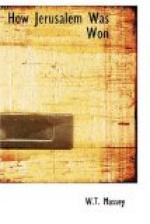On the next two days there was nothing beyond enemy shelling and patrol encounters. On the 24th demonstrations were made against Beitunia to support the left of the 52nd Division’s attack on El Jib, but the enemy was too strong to permit of the yeomanry proceeding more than two miles east of Foka. The roadmakers had done an enormous amount of navvy work on the track between Foka and Tahta. They had laboured without cessation, breaking up rock, levering out boulders with crowbars, and doing a sort of rough-and-ready levelling, and by the night of the 24th the track was reported passable for guns. The Leicester battery R.H.A. came along it next morning without difficulty. I did not see the road till some time later and its surface had then been considerably improved, but even then one felt the drivers of those gun teams had achieved the almost impossible. The Leicester battery arrived at Foka just in time to unlimber and get into action behind a fig orchard in order to disperse a couple of companies of enemy infantry which were working round the left flank of the Staffordshire Yeomanry at Khurbet Meita, below the Zeitun height. The enemy brought up reinforcements and made an attack in the late afternoon, but this was also broken up. The Berkshire battery reached Tahta the following day and, with the Leicester gunners, answered the Turks’ long-range shelling throughout the day and night. On the 27th the enemy made a determined attempt to compel us to withdraw from the Zeitun ridge, which is an isolated hill commanding the valleys on both sides. The 6th Mounted Brigade furnished the garrison of 3 officers and 60 men, who occupied a stone building on the summit. Against them the enemy put 600 infantry with machine guns, and they also brought a heavy artillery fire to bear on the building from Beitunia, 4000 yards away. The garrison put up a most gallant defence. They were compelled to leave the building because the enemy practically destroyed it by gunfire and the infantry almost surrounded the hill, but they obtained cover on the boulder-strewn sides of the hill and held their assailants at bay. At dusk, although the garrison was reduced to 2 officers and 26 men, they refused to give ground. They were instructed to hold on as long as possible, and a reinforcement of 50 men was sent up after dark—all that could be spared, as the division was holding a series of hills ten miles long and every rifle was in the line. This front was being threatened at several points, and the activity of patrols at Deir Ibzia and north of it suggested that the enemy was trying to get into the gap of five miles between the yeomanry and the right of the 54th Division which was now at Shilta. It was an anxious night, and No. 2 Light Armoured Car battery was kept west of Tahta to enfilade the enemy with machine guns should he appear in the neighbourhood of Suffa. The 7th Mounted Brigade was ordered up to reinforce. The fresh troops arrived at dawn on the 28th, and had no sooner got into position




